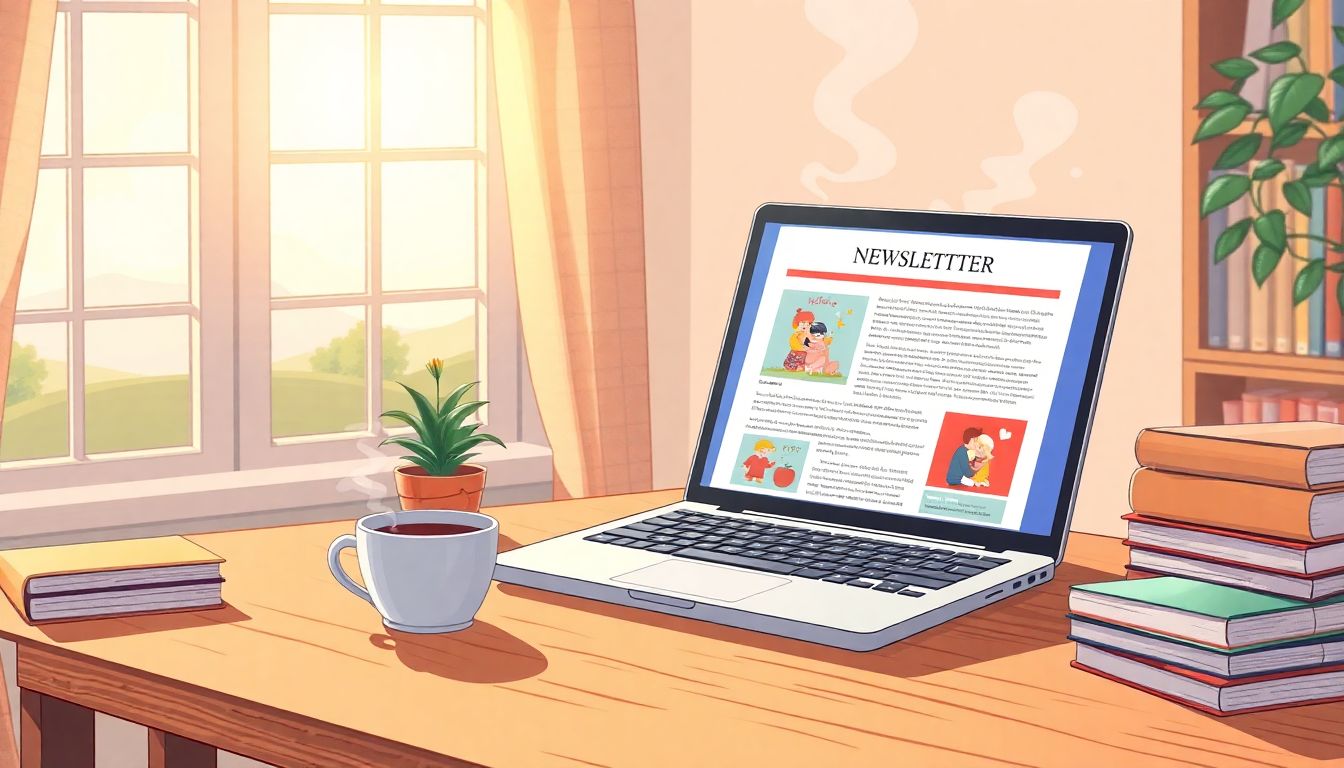I get it—starting an author newsletter can feel scary at first, especially if you have no clue where to begin or worry if anyone will actually read it.
But relax, you’re about to learn exactly how to set up an engaging email list readers will genuinely look forward to opening (no spammy marketing, promise!). Stick around and you’ll see it’s easier—and even more fun—than you’d expect.
Ready? Let’s get you started.
Key Takeaways
- Place your newsletter sign-up form prominently on your website and offer subscribers an attractive freebie like exclusive chapters, bonus content, or coloring pages.
- Choose an affordable and user-friendly email platform like Beehiiv, Mailchimp, or MailerLite and check their deliverability and analytics features.
- Provide entertaining and valuable content, such as behind-the-scenes insights, book recommendations, reader questions, and special promotions to keep subscribers engaged.
- Avoid frequent, overly promotional emails; focus instead on building genuine relationships and carefully proofread emails before sending.
- Regularly review newsletter analytics (open rates above 23%, click-through rates, subscriber growth, unsubscribe rates) and adjust content based on these insights.

Step 1: Start Your Author Newsletter and Grow Your Email List
If you’re an author, your email newsletter is basically your direct line to readers—it’s regular email updates authors send to fans, often including updates on book releases, upcoming events, special discounts, personal notes, or exclusive content people won’t get anywhere else.
A recent survey of over 500 authors showed that newsletters aren’t just useful—they’re a critical tool most successful authors swear by when it comes to connecting with readers and marketing their books.
First things first: you need a clear sign-up form. Don’t bury it at the bottom of your website—stick it front and center where visitors can’t miss it. Bonus tip: Keep it simple and just ask for the email address initially, as extra fields can cause fewer people to sign up.
It’s also a great idea to offer new subscribers a welcome gift, sometimes called a “reader magnet.” This can be a free short story, downloadable coloring pages (especially if you write children’s books—check out how to publish a coloring book), a sneak-peek chapter from your upcoming novel, or exclusive bonus content just for joining. These incentives encourage folks to join your list instead of just scrolling past.
Another easy tip: Ask friends and current readers to share your newsletter sign-up on their social media pages. Word-of-mouth recommendations are often the most powerful way to gain new readers!
Step 2: Pick the Best Email Newsletter Platform for Authors
The right newsletter platform isn’t just about cool templates and pretty designs—it’s key to your growth and how easily you’ll connect with readers. Your chosen platform affects your email deliverability (making sure your emails land in inboxes, not spam folders), analytics (knowing who reads and clicks), and overall usability.
Beehiiv, for example, has seen explosive growth among newsletters in recent years—up 700% in 2023 alone, with over 4.5 billion emails sent on their platform. This kind of traction shows the trust and performance they’ve built in the email newsletter space.
Here are some key factors to consider when picking your email platform:
- Pricing: Start simple and cheap. Some easy-to-use platforms like Beehiiv, Mailchimp, or MailerLite offer free or affordable beginner plans.
- Simplicity: Choose a newsletter platform that’s easy to learn—you don’t need complicated features that you’ll never use, especially at the beginning.
- Analytics: You need clear data. Platforms offering easy-to-understand stats on open rates, click-through rates, and subscriber growth are best for authors.
- Deliverability: Check reviews to see how often emails from that platform land straight in your readers’ inboxes. Average open rates for newsletter platforms range from about 19% to 23%, so aiming higher than that is great.
Try signing up for a handful of newsletter platforms yourself—most offer free trials. Test how intuitive each dashboard feels before deciding on your main one.
Step 3: Plan Content Ideas Your Readers Will Love
Building a list is fantastic, but what you send to subscribers is what keeps them around. Don’t overthink it or get stressed out—just put yourself in your readers’ shoes: what would you want in your inbox every week (or month)?
Mix things up to keep it exciting. Here are some fun and practical ideas to regularly incorporate:
- Behind-the-scenes peeks: Share your writing routine, interesting research tidbits, or glimpses into your creative workspace. Readers love to feel they’re getting insider access.
- Book recommendations: Suggest books you’ve enjoyed reading lately, possibly even tied to your genre. Readers usually trust recommendations from authors they like.
- Engagement boosters: Ask readers direct questions or ask them to reply to your emails, building stronger connections and increasing engagement.
- Prompts and creative ideas: Throw in helpful and seasonal writing prompts—like these cool winter writing prompts that competitors aren’t offering.
- Early announcements and deals: Use your list to announce new releases first and offer exclusive promotions, discounts, or presales. Everyone loves feeling special!
Keep the tone conversational and friendly. Imagine chatting over coffee with your readers—that’s exactly the kind of vibe your newsletters should have. Short, punchy sentences and bullet points also make content super readable on mobile (where most emails are opened these days).

Step 4: Gain More Newsletter Subscribers with Effective Incentives and Promotions
Want readers flocking to your newsletter? Offering incentives makes it happen faster.
One of the best ways to do it is by using what’s known as a “reader magnet.”
This just means giving readers a cool, irresistible freebie for subscribing.
If you write children’s books, publish a special coloring book they can download.
Another good idea: offer exclusive sneak-peek chapters or bonus content people can’t find anywhere else.
To boost promotions, jump on social media regularly to remind folks about your mailing list.
Instagram stories, TikToks, or quick Facebook posts can all remind followers about your special incentive.
Another useful approach: team up with fellow authors to cross-promote each other’s newsletters; partnering up helps everyone involved.
Test ads or sponsored posts on a small monthly budget—just $20-$50 can make a noticeable difference in subscribers.
Finally, always add clear and enticing sign-up links everywhere—your email signature, website footer, even author bios on other platforms.
Step 5: Understand What Mistakes Authors Often Make (And How to Avoid Them)
A common question new authors have: “What mistakes am I likely to make with my author newsletter?”
Here are some classics and how you can dodge these issues from the get-go.
Mistake 1: Sending Too Many Emails. Nobody wants their inbox to explode, right? Stick to once a week at most, or monthly if weekly feels too much.
Mistake 2: Being Too Salesy. You’re not selling cars here—you’re establishing genuine connections. Space promotional content between personal updates, useful tips, or engaging stories.
Mistake 3: Ignoring Analytics. Keep an eye on your open rates (aim for 23% or higher) and click-through rates. Platforms like Beehiiv give clear stats; check monthly to see what’s landing and what’s not.
Mistake 4: Boring Subject Lines. Put effort into your email subject—it decides if people open your email. Be intriguing, witty, or playful—just avoid misleading clickbait.
Mistake 5: Skipping Proofreading. Typos happen but too many can lose subscribers’ trust. Run your newsletters through reliable proofreading software before hitting send.
Avoiding these pitfalls helps you maintain subscribers and sets your newsletter apart in crowded inboxes.
Step 6: Track Newsletter Results to See What’s Working
Ever wondered how authors fine-tune their newsletters? They measure and adjust based on real data.
Check analytics each time after sending a newsletter. Platforms such as Beehiiv, MailChimp, and MailerLite provide straightforward stats dashboards.
Track essential numbers like:
- Open Rate: Anything above 23% is solid. This helps gauge if your subject lines grab attention.
- Click-Through Rate (CTR): Tracks which links or articles were most popular to your readers. High CTR means engaging content—if low, test new ideas.
- Subscriber Growth: If sign-ups stall, refresh your incentives or increase your promotional efforts.
- Unsubscribe Rate: Spot which campaigns or topics might be unpopular, helping you avoid those in the future.
Actively engaging with feedback and carefully looking at the numbers pushes your newsletter forward—don’t just guess what’s working—let real data do the talking.
Lastly, remember this: the number of global email users will reach over 4.73 billion by 2026, meaning your potential audience size is massive.
Regular tracking and tweaking are key to tapping into this growing pool of readers.
Wrapping Up: Keep it Fun and Real
Your author newsletter isn’t just marketing—it’s a personal letter, a friendly update to your fans.
Stay authentic, keep your tone relatable, and don’t shy away from showing your personality.
Ask readers questions, respond to their replies, and keep conversations going.
Try out creative twists—maybe experiment with fun writing prompts like these funny writing prompts for kids to add humor and lightness.
Or, if your readers enjoy exploring darker themes, spice things up with a unique idea from a horror story plot to keep them intrigued.
Consistency is critical too—stick to your chosen schedule; readers enjoy a rhythm they can count on.
Most importantly, enjoy writing your author newsletter because your enthusiasm and warmth shine through, keeping readers excited for every new email.
FAQs
Mailchimp and ConvertKit are popular choices among authors. ConvertKit is designed primarily for content creators and authors, providing simple subscriber management and automated email sequences. Mailchimp offers more templates and integrations, ideal for newcomers starting with newsletters.
Offer compelling reader incentives, like chapter previews, short stories, or exclusive content in exchange for subscriptions. Promoting clear sign-up forms via social media, website pop-ups, and within published books also helps significantly expand an author’s email list quickly.
Authors often slip up by sending emails irregularly, only pushing promotional content, or neglecting to offer value-driven content readers genuinely enjoy. Avoid these pitfalls by sticking to consistent schedules, balancing promotions with engaging content, and maintaining clear, reader-centric messaging.
Open rate, click-through rate, unsubscribe rate, and subscriber growth indicate how effectively your emails resonate with readers. Monitoring these allows authors to determine what content types, subject lines, or promotions effectively engage subscribers.
